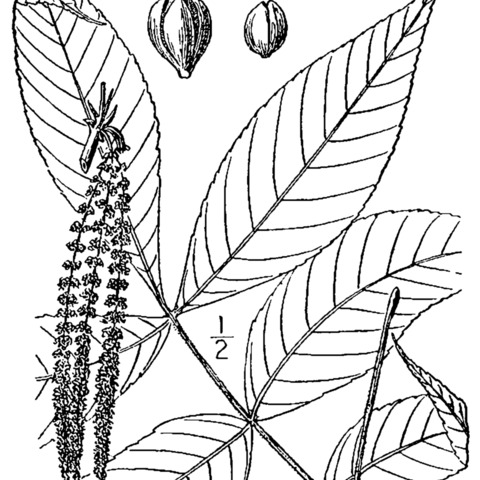Trees , to 29 m. Bark dark gray, ridged, often deeply furrowed. Twigs reddish brown, slender, slightly scaly, sometimes pubescent. Terminal buds reddish brown, ovoid, 4-11 mm, sparsely to densely scaly; outer bud scales with coarse hairs on midribs, bud scales imbricate; axillary buds protected by bracteoles fused into hood. Leaves 3-6 dm; petiole 3-10 cm, rachis sparingly hirsute near base, densely hirsute and scaly distally. Leaflets (5-)7(-9), lateral petiolules 0-1 mm, terminal petiolules 2-5 mm; blades ovate to obovate or elliptic, not falcate, 2-15 × 1-6 cm, margins finely to coarsely serrate, apex acuminate; surfaces abaxially hirsute toward base of midrib, otherwise without hairs or rarely hirsute with unicellular and 2-8-rayed fasciculate hairs, abundant large peltate scales and small 4-lobed, irregular, and round peltate scales imparting silvery tan color, adaxially glabrous except for dense fasciculate hairs at base near leaf insertions, moderately to densely scaly in spring. Staminate catkins pedunculate, to 13 cm, stalks hirsute, scaly, bracts scaly, hirsute at apex; anthers hirsute. Fruits tan to reddish brown, obovoid to spheric or ellipsoid, slightly compressed, 3-4 × 2-3 cm; husks rough, 2-4 mm thick, dehiscing to middle or base, sutures smooth; nuts tan, obovoid to spheric or ellipsoid, slightly compressed, not angled, rugulose; shells thick. Seeds sweet.
More
A large tree. It grows 24 m high. The trunk is 30-60 cm across. The bark is smooth and has deep grooves. The leaves are compound and 18-38 cm long. The leaves have 7-9 leaflets along the stalk. They are light green above and have silver-grey scales underneath. The flowers are very small and greenish. The male flowers are in slender drooping catkins. There are 3 flowers hanging from one stalk. The female flowers occur singly at the tip of the same twig. The fruit is oval and 30 mm long. It splits at the base when ripe. The seed is edible.


